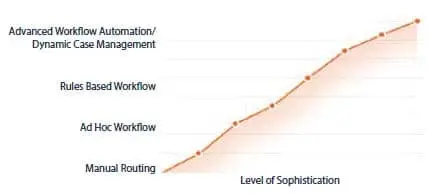Subject to a variety of interpretations, “workflow” can mean anything from the steps in a work process to Business Process Automation.
It is a fairly general term that can be applied to refer to either:
- A collection of business processes which collectively serve to accomplish the business objectives of an organisation.
- An individual business Workflow Process that is defined to accomplish a specific set of business operations (tasks).
- A process is distinguished from a workflow because it has well-defined inputs, outputs (i.e. a work-item) and purposes – Whereas workflow refers more generally to multiple related processes.
A Workflow Process is composed of specific manual and/ or automatic tasks that are connected by paths that allow work to flow based on rules defined within each process.
Workflows can be as simple as filling out and getting travel requests approved, or as complex as the steps involved in connecting disparate departments to manage inventory.
The traditional processes in a business without workflow automation software are tenuous. Employees have to physically hand deliver documents, sort through files, and notify people of tasks they need to complete via email, notes and meetings.
These manual procedures can often be defined, standardised and set to specific business rules in an electronic environment; this is workflow automation.
Workflow automation is a defined set of rules required to accomplish a specific goal; the software is able to automatically route tasks through the process to each subsequent step, all the way to the completion of that goal.
Example
- A salesman incurs an expense and fills out an electronic form directly within the system.
- He takes a photo of his receipt with his iPhone camera and attaches it to the expense form he just completed.
- When he presses the submit button, it is uploaded and deposited into the Document Management repository.
- The system recognises the total amount on the expense form and automatically sends it to the appropriate person for approval prior to accounting receiving it.
- The manager receives a notification on his tablet that an approval must be completed. He opens the form, reviews the receipt, and approves the expense.
- It then gets automatically routed to accounting to kick off the reimbursement workflow and get posted to the appropriate accounts.
Four Kinds of Workflow
There are levels of sophistication in regards to workflow automation.
At the most basic level, it is referred to as manual routing. As the workflow grows in sophistication, it encompasses the capabilities of the more simplistic technology, but also adds an additional layer of functionality and power, effectively creating four different variations of workflow technology.
Manual Routing
Routing involves a very simple workflow where assignments are sent through the system manually. They are very simple, straight line processes that rely solely on user interaction and are not often repeatable.
Ad Hoc
From there, ad hoc workflow is a bit more advanced and can handle more complex processes than manual routing, although they are still unstructured, undefined and typically unrepeatable. It is user initiated; a worker must choose the participants and route for each task.
However, there are limitations with this level of workflow. An ad hoc environment only allows for a user initiated process and does not handle automation, the system relies on people to consistently make correct decisions and act accordingly in a timely manner.
It also cannot handle large volumes of documents or data; only single items can be sent through the workflow.
This will be expanded upon further in the following paragraphs.
Rules Based Workflow
Workflow automation is a big step up from an ad hoc workflow, it allows for pre-determined and standardised processes to be initiated and tasks to be routed without the need for user interaction.
It enables reactive routing that occurs automatically based on value authority, task completion, or specific events as defined by your specific business rules. Capture of a document or an event can automatically trigger a workflow of appropriate business processes involving both automatic and manual tasks.
Process Definitions provide structure and discipline with automated business rules, defined routing paths plus structured, automated and manual tasks which can have multiple steps. Processes are repeatable and standardised so they are consistently and automatically handled by the system.
Rules based workflows are also able to handle highly complex processes and the routing of multiple documents or a large volume of data.

Advanced Workflow Automation
Even within workflow automation, there are subtle differences that dramatically alter the performance of the technology.
Advanced Workflow Automation can be highly-structured, yet accommodate flexibility and knowledge-driven activities and tasks. Your software can then handle transitions between automation where applicable and ad hoc when necessary.
The ultimate goal is to streamline and automate as many tasks as possible, using people where they can be the most efficient and effective to perform tasks that cannot be effectively automated.
The primary variances within workflow automation software are fixed and dynamic queues, parallel process support and sophisticated case management capabilities, which will be explained in further detail below.
Now that the foundation of workflow automation has been set, let’s rewind and delve a bit deeper into each of the aforementioned variables. It was previously explained that ad hoc workflow is a more primitive form of workflow and does not handle automation.
Generally speaking, the inability to automate is major limitation for any organisation. Automation is ideal because it hardens and standardises common processes for consistency and scalability the enterprise. It also eliminates the need for manual and repetitive, allowing workers to focus on value added activities.
Yet there are situations where complete automation simply is not possible and user interaction is required in order to complete each unique process. This is often referred to as Dynamic Case Management.
This is where exceptions become necessary; unpredictable processes. These processes include knowledge workers that must take a proactive role in deciding the fate of each task.
Exceptions too often cripple an otherwise successful process. Sophisticated exception handling must be present and accounted for so that when unpredictable situations arise, the process doesn’t break down.

Workflow Automation
As previously mentioned, there are subtle differences in the technology behind the workflow automation software currently on the market.
A distinct power of having the most sophisticated workflow available is that while advanced capabilities are obtainable, the basic functions are still supported. This allows your business to have all the tools accessible to build a solution that truly fits your needs.
Ideally, your solution is all-encompassing. Thus, when your process requires ad hoc routing, it is available, but when dynamic queues and automation are essential for critical processes, your business will not be crippled by the limitations of your system.
Parallel Process Support
Parallel process support is vital to create a more effective workflow that is flexible and scalable to the growth and changes within a business. Traditional routing and ad hoc workflows are sequential; they follow a step by step order. Unable to support parallel processes, these workflow solutions cannot handle the more complex processes required to most effectively run a business.
More advanced workflow automation solutions al- low for tasks and projects to occur simultaneously. Multiple components of the same process can be completed in parallel; this eliminates unnecessary wait times; tasks are completed quicker and easier.
Dynamic Queues
Workflow automation aims to maximise the value of an organisations most expensive resource; people. However, the majority of processes contain static queues which drastically limit the performance ability of employees. With this style of queue, the general opinion is that the work is assigned to the user, when in actuality; the user is bound to the work. It is a subtle difference, but it drastically changes the functionality of your work- flow.
Static queues are unable to adapt to the changing business environment. What if multiple employees are able to complete the same task? What if a user has work items across departments, and not within the same process? These fixed queue’s quickly break down under pressure. Ideally, your workflow should support static queues for simplicities sake, while also supporting the enhanced capabilities of a content and people centric workflow which utilise dynamic queues. This creates a more powerful and flexible workflow environment.
Dynamic queues consist of all the tasks each employee is subscribed or assigned to, in order of their particular priorities. These queues may have one or many users with access to them, depending on the number of people appointed to each particular task. As work items are completed or priorities change, the dynamic queue will adapt in real time, allowing for your workflow to become a flexible and intuitive part of the business.
Example
- Bob handles quote requests, invoice processing and order approvals over $5,000.
- Sue handles invoice processing, new hire processing and order approvals under $5,000.
- Bob and Sue have separate dashboards – their Dynamic Queues – within their workflow viewer.
- Bob is currently processing quote requests, when an invoice enters the workflow.
- Bob and Sue both see this item appear in their Dynamic Queue.
- Bob’s other quote requests must be completed first, as these are his priority over invoice processing.
- However, invoice processing has been set as Sue’s top priority.
- Sue accepts the task and completes it, sending it on to the next checkpoint in the process and it disappears from both Sue and Bob’s Dynamic Queue.
- Bob’s other quote requests must be completed first, as these are his priority over invoice processing.
- However, invoice processing has been set as Sue’s top priority.
- Sue accepts the task and completes it, sending it on to the next checkpoint in the process and it disappears from both Sue and Bob’s Dynamic Queue.
- In contrast, with fixed queues, tasks are sent only to specific users.
- If Bob is set up to process all invoices, as this form of workflow cannot handle multiple users with the same responsibilities effectively, then the task enters Bob’s queue.
- He must finish the quote requests first, as these are his primary responsibility, so those invoice items may not be completed for hours or even days.
- This example is just one scenario, hundreds of these processes are happening in all departments across an organisation. The bottlenecks and delays quickly add up.
Mobile Support
Mobile support adds another layer of functionality to your content management system; it is the extra horsepower in your ECM engine. Mobile access means workers can approve tasks and route documents anytime, anywhere. Process bottlenecks are drastically reduced when users are empowered with remote access.
Organisations are able to both input information into their system and drive their back end processes through their mobile device.
The AIIM Process Revolution report1 found that 67% of respondents believe mobile technologies are vital in improving business processes. Others have described mobile capabilities as the next frontier in business process improvement.
Even if your organisation is not currently promoting mobile support, it is an important consideration for the future and it may be beneficial to set the foundation within our current system to sup- port remote access when the time comes for your enterprise.
Easy to Manage, Design, & Use
The most powerful workflow automation solutions can be managed, altered and maintained with no coding or programming requirements.
Easy to use, flexible systems allow the workflow to be adjusted to changing business needs without IT involvement. An easy to understand interface ensures that business leaders, end users, and IT alike are all capable of utilising workflow automation.
One way to test whether the system is easy to use or not is, during the initial evaluation, ask the vendor to change a workflow and see how long it will take. If it takes more than a few hours, that is a major red flag. If the experts cannot adjust a process quickly, how long might it take your company to react to changing business operations?
Defining Your Processes
Workflow automation must find the balance between simply turning your existing processes into an electronic format, and re-engineering your organisation. It is not a replacement, but rather the bringing together of people, processes and technology.
Workflow automation should not simply replicate a bad business process; it should improve it. One of the key benefits of workflow automation is the ability to develop a more efficient business, so process improvements will occur naturally as you begin to define and map out key processes. Yet, workflow is not a tool to build radically new and different processes. The key is to strip out unnecessary steps, standardise the repeatable processes and specify the path the workflow must take.
When actually applying workflow automation, it is first necessary to define the core business processes. Even those that appear not be repeatable are typically set upon a standard foundation. This discovery phase is absolutely vital for a successful implementation and adoption of the new technology. The key is in finding the baseline and then customising the workflow to fit the specific nuances and requirements of the business. Workflow automation is more than simply choosing the right technology; it is about choosing the right partner than can guide the organisation through these vital first steps.
Benefits of Workflow Software
There will be overarching advantages common across any organisation when applying workflow automation; reducing costs, improving operations, generating greater revenue. Yet, there are also unique benefits to each company based on their specific goals and considerations.
- For example, ClosetMaid described the complete process visibility they gained into their manufacturing operations as one of the critical advantages they gained after implementation
- Lockheed Martin utilised the technology to synchronise communication between the production floor and the front office.
- The Antigua Group took a 3-day process and shortened it to 24 hours, a major benefit to their operations.
So you can see that the value workflow automation provides will vary greatly depending on the organisation, but overall there are always major benefits provided when any company implements a solution to improve their business processes.
About Dajon
With deeply integrated document management and process automation software solutions from Dajon, organisations such as Goodwill Industries, Lockheed Martin and Morton Plant Mease Hospital have met their objectives by streamlining their processes and simplifying their work-place. With our technology, organizations are able to eliminate paper and unnecessary costs while allowing them to do more work with limited resources.
Our goal is to help companies gain greater control over their operations. By integrating with your existing systems, such as your accounting software and enabling instant access to all the information within your office, you can expect dramatic improvements in efficiency and productivity.
